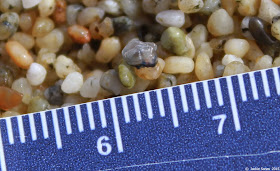Okay, okay — I know I've written about By-the-wind Sailors (Velella velella) a few times already in March. But I haven't seen this many wash ashore at once since 2006, so I'm posting a few pictures to document this event and to record a few notes.
I wrote about small Velella (only 1-5 mm long) washing ashore on 24 March and 27 March. Local beaches are now blue with larger Velella, many 30-40 mm long, and the largest ~60 mm long.
Here's another image showing the density on 31 March 2015:
The next two pictures are close-ups to document the sizes present.
Below, scan carefully for very small Velella, too —
I can't imagine how many Velella have stranded during the last few days. Their extreme density makes counting a challenge.
I had started to wonder if it was common to see such a wide range of sizes at one time.
Last summer I posted a couple of graphs: one showing records of Velella sizes, and another illustrating a prediction of Velella's annual cycle of growth and reproduction.
Here's the first graph (below) from Bieri (1977). The vertical solid lines show the lengths of Velella recorded at different locations in different years.
Note that it looks like it's relatively unusual to have very small Velella (under 5 mm) and larger Velella present during the same event —
e.g., the lines in the middle of the graph hardly ever reach the bottom, and the short lines that start at the bottom don't extend very far up.
The distribution of sizes we're seeing on the beaches at this time match Bieri's prediction fairly well (although the timing might be different). Check out the next graph below. The purple line represents abundances of different sizes. For February, he predicts lots of small Velella (10 mm and under), good numbers of 20-30 mm Velella, and some up to ~40-45 mm. That was the situation here in early March. Now we're seeing more Velella in the 30-40 mm range, and the largest in the 60 mm range, so even though we're turning the corner into April, perhaps we're transitioning into his March prediction.
Are you seeing Velella in your area? How many? What sizes are you seeing? Although it can be sad to see so many wash ashore, it's also an opportunity to contribute to what's known about their life history.
Graphs above from Bieri, R. 1977. The ecological significance of seasonal occurrence and growth rate of Velella (Hydrozoa). Publ. Seto Mar. Biol. Lab. 24: 63-76.




















































